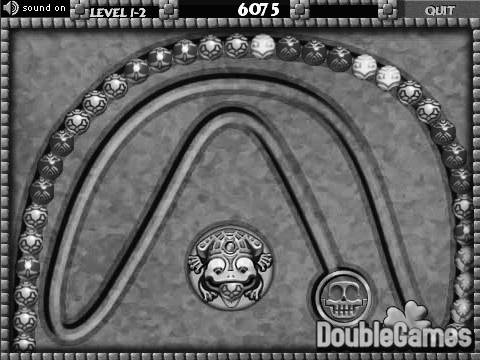有想要数据的可以私我哦 评论一下就可以
【问题描述】
祖玛是一款曾经风靡全球的游戏,其玩法是:在一条轨道上初始排列着若干个彩色珠子,其中任意三个相邻的珠子不会完全同色。此后,你可以发射珠子到轨道上并加入原有序列中。一旦有三个或更多同色的珠子变成相邻,它们就会立即消失。这类消除现象可能会连锁式发生,其间你将暂时不能发射珠子。
开发商最近准备为玩家写一个游戏过程的回放工具。他们已经在游戏内完成了过程记录的功能,而回放功能的实现则委托你来完成。
游戏过程的记录中,首先是轨道上初始的珠子序列,然后是玩家接下来所做的一系列操作。你的任务是,在各次操作之后及时计算出新的珠子序列。
【输入格式】
第一行是一个由大写字母'A'~'Z'组成的字符串,表示轨道上初始的珠子序列,不同的字母表示不同的颜色。
第二行是一个数字 ,表示整个回放过程共有 次操作。
接下来的 行依次对应于各次操作。每次操作由一个数字 和一个大写字母 描述,以空格分隔。其中, 为新珠子的颜色。若插入前共有 颗珠子,则 表示新珠子嵌入之后(尚未发生消除之前)在轨道上的位序。
【输出格式】
输出共n行,依次给出各次操作(及可能随即发生的消除现象)之后轨道上的珠子序列。
如果轨道上已没有珠子,则以“-”表示。
【样例输入】
ACCBA
5
1 B
0 A
2 B
4 C
0 A
【样例输出】
ABCCBA
AABCCBA
AABBCCBA
A
【样例解释】
你以为山里又有座庙?
【数据规模与约定】
100%的数据满足1<=n<=10^3,1<=m<=2*10^3。
思路:
一道恶心的模拟题,注意数据可能开始就有连着的三个球....
代码
#include <cstdio>
#include <cstring>
const int SZ = 1<<20; //快速io
char ch[20001];
char temp[20001];
int size=0,pos;
int res(int a)
{
int head = a,last = a;
char elem;
elem = ch[a];
while(ch[head] == elem && head) head--;
if(head || ch[head] != elem) head++;
while(ch[last] == elem && last < size) last++;
if(last - head > 2)
{
strcpy(temp,ch + last);
strcpy(ch + head, temp);
size = size + head - last;
pos = head;
return 1;
}
else
return 0;
}
int main()
{
int i = 0;
int n;
char e;
gets(ch);
while(ch[size] >= 'A' && ch[size] <= 'Z')size++;
scanf("%d", &n);
while(n--)
{
scanf("%d %c",&pos,&e);
strcpy(temp, ch + pos);
strcpy(ch + pos + 1, temp);
ch[pos] = e;size++;
while(res(pos) && size);
if(size)
puts(ch);
else
puts("-");
}
return 0;
}
//莫名80
#include <cstdio>
#include <cstdlib>
#include <cstring>
#include <algorithm>
using namespace std;
const int maxn = 2000;
const int maxm = 160010;
int len;
char str[maxm * maxn];
struct Node {
char type;
Node *next, *last;
Node (char c) {
type = c;
next = last = NULL;
}
}*head, *tail;
int main() {
freopen("ha.in","r",stdin);
freopen("ha.out","w",stdout);
head = tail = NULL;
int n;
char c;
while (1) {
scanf("%c", &c);
if (c == '\n') break;
Node *n = new Node(c);
n -> last = tail;
if (tail) tail -> next = n;
tail = n;
if (!head) head = n;
}
len = 0;
scanf("%d", &n);
while (n--) {
int pos;
char t[3];
scanf("%d %s", &pos, t);
Node *now = head;
for (int i = 0; i < pos; ++ i)
now = now -> next;
//insert
Node *newnode = new Node(t[0]);
if (!head && !tail) {
head = tail = newnode;
} else {
newnode -> next = now;
if (now) {
newnode -> last = now -> last;
if (now -> last) now -> last -> next = newnode;
else head = newnode;
now -> last = newnode;
}
else {
tail -> next = newnode;
newnode -> last = tail;
tail = newnode;
}
}
//modify
while (1) {
while (newnode -> next && newnode -> type == newnode -> next -> type) newnode = newnode -> next;
int cnt = 1;
while (newnode -> last && newnode -> type == newnode -> last -> type)
cnt ++, newnode = newnode -> last;
if (cnt > 2) {
while (cnt --) {
if (newnode -> last) newnode -> last -> next = newnode -> next;
if (newnode -> next) newnode -> next -> last = newnode -> last;
Node *tmp = newnode;
if (head == newnode) head = head -> next;
if (newnode -> next) newnode = newnode -> next;
else {
newnode = newnode -> last;
tail = newnode;
}
delete tmp;
}
} else break;
if (!newnode) {
head = tail = NULL;
break;
}
}
if (!head) str[len++] = '-', str[len++] = '\n';
//puts("-");
else {
for (Node *p = head; p; p = p -> next)
str[len++] = p -> type;
//printf("%c", p->type);
str[len++] = '\n';
//puts("");
}
}
printf("%s", str);
return 0;
}//80
#include<cstdio>
#include<algorithm>
#include<cstring>
#define N 4010
using namespace std;
char a[N];
int n,m;
int main(){
gets(a+1);
n=strlen(a+1);
scanf("%d",&m);
while(m--){
int pos,l,r;char s[10];
scanf("%d%s",&pos,s);
for(int i=n+1;i>=pos+2;i--) a[i]=a[i-1];
n++;
a[pos+1]=s[0];
while(true){
for(l=pos;(l>=1)&&(a[l]==a[pos+1]);l--) continue;
for(r=pos+2;(r<=n)&&(a[r]==a[pos+1]);r++) continue;
int len=r-l-1;
if(len>=3){
pos=l;n-=len;
for(int i=pos+1;i<=n;i++) a[i]=a[i+len];
for(int i=n+1;i<=n+len;i++) a[i]=0;
a[n+1]=0;
}
else break;
}
if(n==0) printf("-\n");
else printf("%s\n",a+1);
}
return 0;
}【问题描述】
栈是一种强大的数据结构,它的一种特殊功能是对数组进行排序。例如,借助一个栈,依次将数组1,3,2按顺序入栈或出栈,可对其从大到小排序:
1入栈;3入栈;3出栈;2入栈;2出栈;1出栈。
在上面这个例子中,出栈序列是3,2,1,因此实现了对数组的排序。
遗憾的是,有些时候,仅仅借助一个栈,不能实现对数组的完全排序。例如给定数组2,1,3,借助一个栈,能获得的字典序最大的出栈序列是3,1,2:
2入栈;1入栈;3入栈;3出栈;1出栈;2出栈。
请你借助一个栈,对一个给定的数组按照出栈顺序进行从大到小排序。当无法 完全排序时,请输出字典序最大的出栈序列。
【输入格式】
输入共2行。
第一行包含一个整数n,表示入栈序列长度。
第二行包含n个整数,表示入栈序列。输入数据保证给定的序列是1到n的全排列,即不会出现重复数字。
【输出格式】
仅一行,共n个整数,表示你计算出的出栈序列。
【样例输入】
3
2 1 3
【样例输出】
3 1 2
【样例解释】
这回山里有座塔。
【数据规模与约定】
对于30%的数据1<=n<=10^3。
对于60%的数据1<=n<=10^5。
对于100%的数1<=n<=10^6。
思路
可以用stl,要让字典序尽量大,所以最先输出的数尽量大
代码
#include<stack>
#include<cstdio>
#include<iostream>
#define MAXN 1000010
using namespace std;
stack<int> s;
int n;
int m[MAXN],a[MAXN];
inline void read(int&x) {
int f=1;x=0;char c=getchar();
while(c>'9'||c<'0') {if(c=='-') f=-1;c=getchar();}
while(c>='0'&&c<='9') x=10*x+c-48,c=getchar();
x=x*f;
}
int main() {
freopen("haha.in","r",stdin);
freopen("haha.out","w",stdout);
read(n);
for(int i=1;i<=n;i++) read(a[i]);
for(int i=n;i>=1;i--) m[i]=max(a[i],m[i+1]);
s.push(a[1]);
for(int i=2;i<=n;i++) {
while((!s.empty())&&(s.top()>m[i]))
printf("%d ",s.top()),s.pop();
s.push(a[i]);
}
while(!s.empty()) printf("%d ",s.top()),s.pop();
fclose(stdin);
fclose(stdout);
return 0;
}
【问题描述】
小Q对计算几何有着浓厚的兴趣。他经常对着平面直角坐标系发呆,思考一些有趣的问题。今天,他想到了一个十分有意思的题目:
首先,小Q会在x轴正半轴和y轴正半轴分别挑选n个点。随后,他将x轴的点与y轴的点一一连接,形成n条线段,并保证任意两条线段不相交。小Q确定这种连接方式有且仅有一种。最后,小Q会给出m个询问。对于每个询问,将会给定一个点P(px,py),请回答线段OP与n条线段会产生多少个交点?
小Q找到了正在钻研数据结构的你,希望你可以帮他解决这道难题。
【输入格式】
第1行包含一个正整数 ,表示线段的数量;
第2行包含 个正整数,表示小Q在x轴选取的点的横坐标;
第3行包含 个正整数,表示小Q在y轴选取的点的纵坐标;
第4行包含一个正整数 ,表示询问数量;
随后m行,每行包含两个正整数 ,表示询问中给定的点的横、纵坐标。
【输出格式】
共m行,每行包含一个非负整数,表示你对这条询问给出的答案。
【样例输入】
3
4 5 3
3 5 4
2
1 1
3 3
【样例输出】
0
3
【样例解释】
然后塔里啥都没有。
【数据规模与约定】
对于50%的数据1<=n,m<=2*10^3,。
对于100%的数据1<=n,m<=2*10^5
坐标范围<=10^8;
思路
我们可以发现想 x,y 轴的点要想不相交
那就要把坐标小的点相连,那么可以先把 x,y 轴的点排序
在相连就可以了
如果p点和第i条直线相交,那么和它前i条线一定相交
那么我们可以二分来找最多和多少直线相交就可以了
代码
#include<cstdio>
#include<cstring>
#include<algorithm>
#define inf 1e9
#define maxn 200010
using namespace std;
int n,m,a[maxn],b[maxn];
struct node{
int x,y;
}p[maxn];
inline void read(int&x){
x=0;int f=1;char c=getchar();
while(c<'0'||c>'9') {if(c=='-')f=-1;c=getchar();}
while(c>='0'&&c<='9') x=x*10+c-'0',c=getchar();
x=x*f;
}
inline bool Judge(int i,int x,int y){
double Y=(double)p[i].y-(double)x*(double)p[i].y/(double)p[i].x;
return Y<=y;
}
int main() {
freopen("hahaha.in","r",stdin);
freopen("hahaha.out","w",stdout);
read(n);
for(int i=1;i<=n;i++) read(a[i]);
for(int i=1;i<=n;i++) read(b[i]);
sort(a+1,a+1+n);
sort(b+1,b+1+n);
for(int i=1;i<=n;i++) p[i].x=a[i],p[i].y=b[i];
n++;
p[n].x=inf;
p[n].y=inf;
read(m);
int x,y;
while(m--){
read(x);read(y);
int l=0,r=n,pos=0;
while(l<=r){
int mid=l+r>>1;
if(Judge(mid,x,y)){
l=mid+1;pos=max(pos,mid);
}
else r=mid-1;
}
printf("%d\n",pos);
}
return 0;
}


























 511
511

 被折叠的 条评论
为什么被折叠?
被折叠的 条评论
为什么被折叠?








